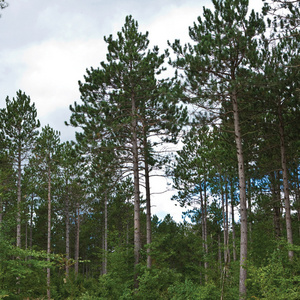Forest Service exceeds yearly forest restoration goals




December 4, 2014
BY U.S. Forest Service
The U.S. Forest Service recently announced that it exceeded its forest restoration goals for fiscal year (FY) 2014, highlighting the agency’s continued commitment to improving the health of the America’s National Forests, reducing the threat of catastrophic wildfire, and protecting watersheds.
“The Forest Service has made strategic investments across all agency programs to advance our efforts to create resilient forests and sustainable communities,” said U.S. Forest Service Chief Tom Tidwell. “This work reduces the wildland fire threat to communities and firefighters and minimizes the risk of forest pests and climate change, while supporting American jobs and rural economies.”
In Fiscal Year 2014, the Forest Service met or exceeded its restoration goals. Projects lessened the threat to communities by reducing hazardous fuels on 1.7 million acres in the wildland urban interface, sustained or restored watershed conditions on 2.9 million acres and resulted in 2.8 billion board feet of timber volume sold. The agency met its goals in a year where it lost staff time due to the government shutdown and when it continued to confront rising costs of fire-fighting that drain resources from forest restoration and management activities.
Advertisement
Advertisement
The Forest Service was also successful in leveraging partnerships to help meet its ecological restoration goals. Partners, including conservation groups, forest industry, local communities, sportsmen, and others assisted with monitoring of resource conditions and project implementation as a component of adaptive management. The diverse programs, tools and activities used include: the Collaborative Forest Landscape Restoration Program, Stewardship Contracting Authority , Good Neighbor Authority and other 2014 Farm Bill provisions. The agency will continue to expand use of these authorities in the coming year.
Tidwell said that for Fiscal Year 2015 the Forest Service is positioned to accelerate efforts to restore forest health and reduce wildland fire threats to communities. Current bipartisan legislation supports the Obama Administration’s call for a change in how wildfire suppression is funded and that would free up more funding to implement projects to improve the resiliency of forests and rangelands. The agency’s 2015 budget request to Congress included more funding for key programs to allow the Forest Service to increase acres treated and timber harvests to 3.1 billion board feet. This adjustment will allow the Forest Service to continue to reduce wildland fire threats to communities while shrinking the agency’s total budget request for 2015.
The 2014 Farm Bill also included a provision that allowed governors to recommend, with secretarial approval, the designation of 44 million acres where the Forest Service can use insect and disease authority to more quickly address forest health issues.
Nationwide, 23 CFLR projects provide economic support to local communities. In FY 2013, those projects helped create or maintain over 5,300 part and full-time jobs, bringing total labor income for that year to over $195 million. Collectively, between FY 2010-2013, the projects generated 838 million board feet of timber sold and nearly 2 million green tons of woody biomass, available for bio-energy production. The FY 2014 statistics will be available in early December and are expected to be higher than FY 2013 contributions. The Agency will continue to implement these projects in FY 2015 as a pathway to achieve the 3.1 billion board feet of timber harvest target. USDA and the Forest Service are also working to support expanding markets for biomass for energy and building materials.
Advertisement
Advertisement
America’s natural resources are integral to the social, ecological, and economic well-being of the nation, and the Forest Service plays a vital role in their care for current and future generations. The Forest Service’s restorative actions draw on multiple programs and are implemented by prioritizing investments and managing performance to best meet the goals for resilient landscapes. They improve ecosystems’ ability to absorb, or recover from, the effects of disturbances through preservation, restoration, or improvement of its essential structures and functions and redundancy of ecological patterns across the landscape.
The mission of the Forest Service, part of the U.S. Department of Agriculture, is to sustain the health, diversity, and productivity of the Nation's forests and grasslands to meet the needs of present and future generations. The agency manages 193 million acres of public land, provides assistance to state and private landowners, and maintains the largest forestry research organization in the world. Public lands the Forest Service manages contribute more than $13 billion to the economy each year through visitor spending alone. Those same lands provide 20 percent of the Nation's clean water supply, a value estimated at $7.2 billion per year. The agency has either a direct or indirect role in stewardship of about 80 percent of the 850 million forested acres within the U.S., of which 100 million acres are urban forests where most Americans live.
Related Stories
The U.S. Department of Energy Bioenergy Technologies Office (BETO) announced up to $23 million in funding to support research and development (R&D) of domestic chemicals and fuels from biomass and waste resources.
The U.S. DOE has announced its intent to issue funding to support high-impact research and development (R&D) projects in two priority areas: sustainable propane and renewable chemicals and algal system cultivation and preprocessing.
Sens. Sherrod Brown, D-Ohio, and Pete Ricketts, R-Neb., in August introduced the Renewable Chemicals Act, a bill that aims to create a tax credit to support the production of biobased chemicals.
The Chemical Catalysis for Bioenergy Consortium, a consortium of the U.S. DOE’s Bioenergy Technologies Office, has launched an effort that aims to gather community input on the development of new biomass processing facilities.
USDA on March 8 celebrated the second annual National Biobased Products Day, a celebration to raise public awareness of biobased products, their benefits and their contributions to the U.S. economy and rural communities.
Upcoming Events










